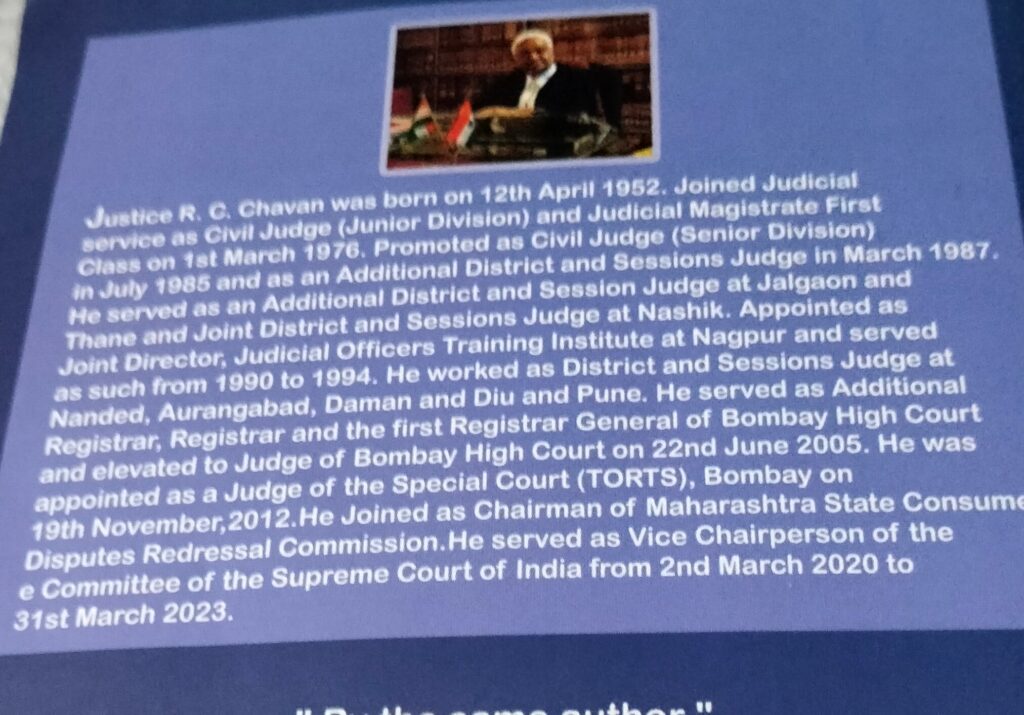Book Written by Justice R.C. Chavan, Former Judge Bombay High Court
(Prof Shankar Chatterjee, Hyderabad)
A wonderful book published by Justice R.C. Chavan, former Judge Bombay High Court, has given me a different flavour because such books I have seldom read. After reading the book “Who Killed the Rule of Law?” (published in November 2023, price Rs.150), I congratulate Justice R.C. Chavan, as the entire volume has been written lucidly and eruditely. He was born on April 12, 1952, and at 24 years of age (March 1976), he joined the judicial service as a civil judge in Maharashtra. From time to time, he served in various capacities in the judiciary, including the Bombay High Court. He was the first Registrar General of the Bombay High Court. I have known Justice Chavan for many years since I met him at an academic conference, and I respect him like my elder brother.
The book (seven chapters) pertains to his observations on legal issues, but anyone can understand by reading it, as legal words are very few, although examples have been cited about different legal issues. He has asked, “Are the poor people suffering because of some loopholes in the legal system?” He has referred Justice S.B. Sinha, former judge of the Supreme Court, who mentioned, “Shall we not take seriously the allegation made by the former President of India, Dr. A.P. J. Abdul Kalam, that the criminal justice system in India is about punishing or sending to gallows only the poor?”
As recorded in the book, one interesting observation of the author is that “there are 150 judges for one million people in the USA (around 49,500 judges). Against this backdrop, “14 judges for one million people in India” (around 18,200 judges). The author feels that “this is said to be the cause for pendency, delays, and all other evils.”
The author has highlighted the delays in justice or the long periods it takes to give the verdict, for which innocents suffer. The author has also highlighted the faulty police investigation in many cases. By referring to Justice Dr. Chandrachud (August 17, 2019), Justice Chavan has observed that “court-monitored investigations show better results.”
Another highlighting line is that “more than three thousand undertrials are rotting in jails for more than five years,” which is very unfortunate. The author feels that why do cases like “Ankush Maruti Shinde or Nithari Killings Happen?”
In the last chapter i.e. in chapter-7 under the title of “Collegium and Memorandum of procedure” the author has extended some suggestions a few of which are presented here.
“If a correction has to be immediately applied, it ought to be in the selection of judges, Collegium was condemned by the Supreme Court too in the NJAC judgment, but neither the Union Government nor the Supreme Court came up with a new memorandum of procedure”.
According to the author, “since none of those responsible for taking up drafting of a new memorandum of procedure, let me outline some ideas which could in the interregnum be tested”.

a) “On June 1 and December 1, every year let every High Court find vacancies for the High Court as well as vacancies all trial courts and tribunals. Existing vacancies as well as vacancies to occur in the next six months should be added”.
b) “Examine all pendency and pattern of institution as well as dispose figures, and backlogs to identify areas of litigation which may be relevant while scouting talent”.
c) “Simultaneously, check with reference to available databases the performance of existing manpower (expertise of judges) to meet the requirement and identify the shortfall for each category of litigation”.
d) “Decide on zone of consideration or the catchment area by applying objective standards, like numbers available in pool, their length of practice where relevant, lower and outer limits and desired age groups to ensure long term availability, healthy competition, possibilities and necessity of limiting zone of consideration by number of years of practice”.
e) “Announce the results of these steps so that persons in the zones can evaluate the options. Those in the zones who may inform that they are not desirous of being considered may be excluded”.
f) “While selecting persons to be recommended for judgeships in the High Courts, identify from the available pool persons whose talents will be specially needed for filling up deficiencies in the available talent pool. Also identify persons on the basis of their age to have a good mix of those who will have different terms to ensure coherence and avoid unhealthy completion and leg pulling”.
g) “Just as minutes of collegium meetings are put on the website, put all the information which has gone into the process of recommendations on the website. CJI Chandrachud has not only opened up judgment databases and case histories, but is also vigorously pushing for live streaming of court proceedings. So at least let the data which has gone into decision making be made public”.
“The entire information may be shared with all the judges of the High Court as also with the Government. Their views too may be included while making recommendations. When this exercise is undertaken for the first time, data collection and analysis may take time. But thereafter only incremental data for six months will have to be added and analysed, which IT experts may facilitate. Only then will the judiciary show that there is no nepotism in the selection process. This will enhance public confidence in the system”.
I have highlighted only a few points from this great and wonderful publication.
(Author is a former Professor & Head (CPME),NIRD & PR, Hyderabad, India)

He could have initiated these reforms while in the judiciary.Now it has no value accept academic venture. Good , atleast he thought about making his mind public.
Well reviewed Shankar jee.